#Temple of Khnum
Photo
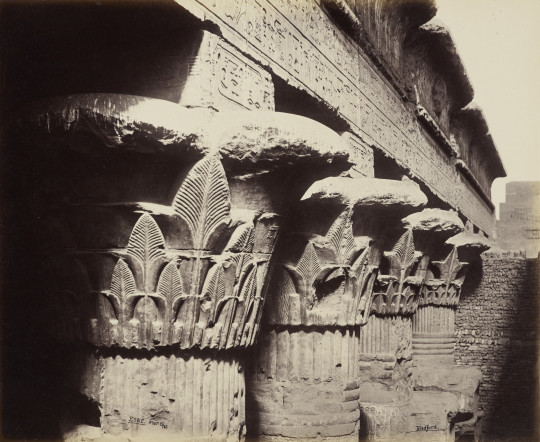
Upper Part of the Great Portico, Esna by Francis Bedford
English, dated March 15, 1862
albumen print mounted on card
Royal Collection Trust
#Esna#Temple of Khnum#Ancient Egypt#Egypt#Francis Bedford#English#photography#historical photography#albumen print#ruins#columns#temple#portico#Royal Collection Trust
154 notes
·
View notes
Text
Absolutely stunning relief. So much remaining colour.
86 notes
·
View notes
Text
Aswan
One of the hottest, driest, and sunniest cities in the world, Aswan with its 350,000 population made a nice change after the 20 million people in Cairo. It is the gateway to the Nile, home to the Aswan and High Dams, which after thousands of years changed the nature of the Nile, for good and bad.
One of the most popular sights is the incredible Philae Temple, the last to be built by the ancient…

View On WordPress
#Aga Khan Mausoleum#Aswan#Aswan Bazaar#Aswan Botanical Gardens#Aswan Museum#Coptic Orthodox Cathedral of the Archangel Michael#Egypt#Elephantine Island#Feryal Garden#Nubian Museum#Nubian Village#Philae Island#photography#Temple of Khnum#The Nile#travel
0 notes
Text

the god Khnum accompanied by Heqet, moulds Why in a relief from the birth temple at Dendera Temple Complex.
120 notes
·
View notes
Text


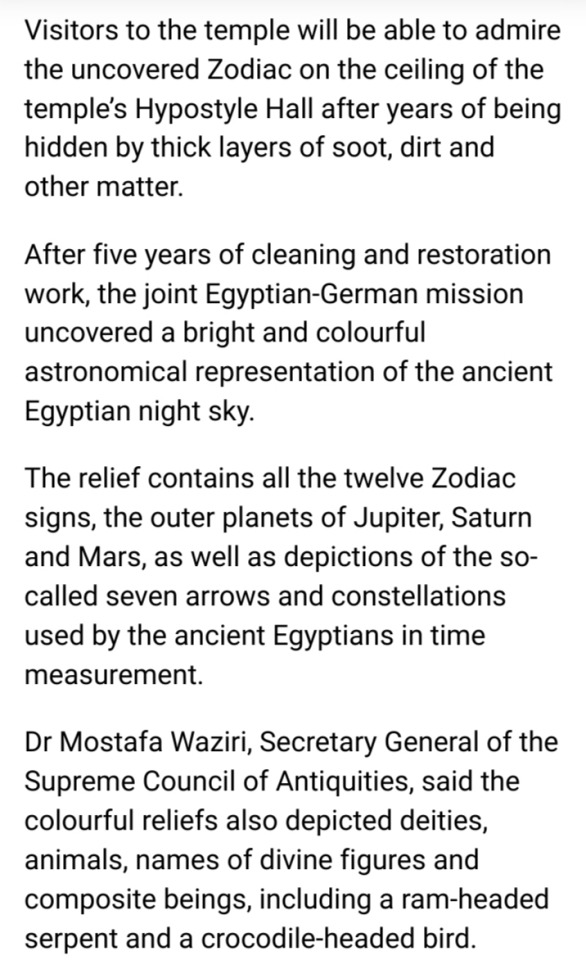

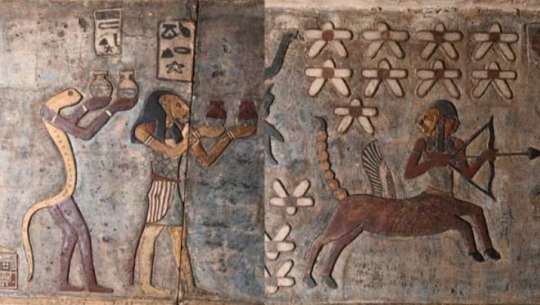

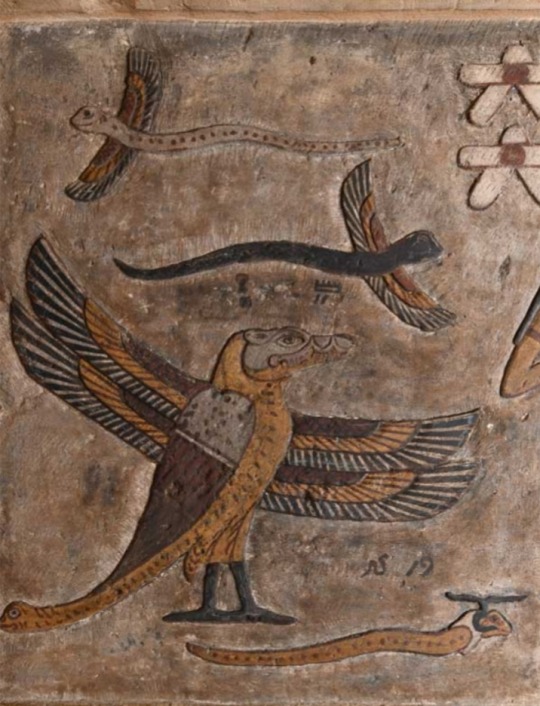
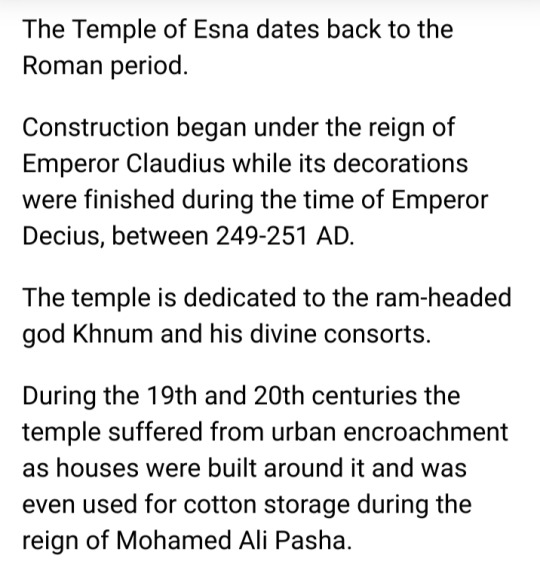

#Temple of Esna#Luxor#Zodiac#Ministry of Tourism and Antiquities#Hypostyle Hall#zodiac signs#Supreme Council of Antiquities#Babylonian astronomy#American Research Centre#Emperor Claudius#Emperor Decius#Khnum#archaeology
123 notes
·
View notes
Text
In a major discovery, archaeologists have found over 2000 mummified ram heads in the Temple of Ramesses the Great in Abydos, along with mummified goats, dogs, wild goats, cows, deer, and an ostrich!
#mummified animals#ram#Khnum#Ramesses II#Ramesses the Great#Sixth Dynasty#Abydos#temple#ancient#history#ancient origins
31 notes
·
View notes
Photo


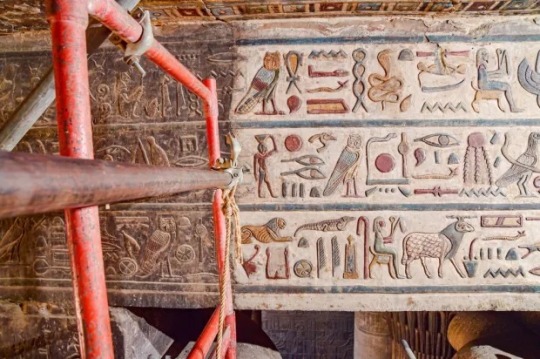




Incredible Colorful Ceiling Frescoes Discovered In Ancient Egyptian Temple
Two millennia's worth of soot and dirt covered the ceiling frescoes in the temple of Khnum in the Egyptian city of Esna, protecting the colors underneath. Now, painstaking restoration work from archeologists has brought these incredible pieces of art back to life.
The frescoes have 46 images of vultures, representing, in turn, the Upper-Egyptian vulture goddess Nekhbet and the Lower-Egyptian serpent goddess Wadjet, who is also depicted as a vulture with open wings, although keeping the head of a cobra and the crown of Lower Egypt. Nekhbet is wearing the Upper Egypt crown.
The restoration was conducted by the Institute for Ancient Near Eastern Studies at the University of Tübingen and the Egyptian Ministry of Tourism and Antiquities. They have been working since 2018 to bring the colors of the frescoes back into view.
“Temples and ancient depictions of the gods were often painted in brilliant colors, but these have usually faded or even disappeared totally as a result of external influences,” Professor Christian Leitz from the University of Tübingen, said in a statement.
The temple was dedicated to one of the earliest Egyptian deities, Khnum the ram-headed god who was seen as the god of the source of the Nile. At Esna, Khnum and his consort Neith are treated as the creator deities.
Construction of the religious building had begun during Ptolemaic time but most of the remaining parts are from the Roman era, probably around the time of Emperor Claudius (41-54 CE). The temple began to attract the interest of archeologists in Napoleonic times, but it was in the latter part of the last century that a more detailed study of it began in earnest.
“From the 1950s, the French Egyptologist Serge Sauneron systematically documented the Temple of Khnum at Esna and the paintings that were visible at that time,” said Tübingen scientist Dr. Daniel von Recklinghausen, “The temple’s complete range of images is unique in its wealth of figures and the state of preservation of the colors.”
“For the first time we can see all the decorative elements in relation to one another,” said Leitz. “This was impossible simply with Sauneron’s publication.”
The whole restoration was funded by the American Research Center in Egypt, the Ancient Egypt Foundation, and the Gerda Henkel Foundation. The team is now planning to translate all of the Esna inscriptions, as well as study the connection between all the images and writing in the temple. This upcoming work has been funded by the German research foundation.
#Incredible Colorful Ceiling Frescoes Discovered In Ancient Egyptian Temple#the temple of Khnum in Esna Egypt#archeology#archeol#ancient frescoes#ancient art#egyptian art#art#artist#art work#art news#history#history news#ancient history#ancient culture#ancient civilizations#ancient egypt#egyptian history#egyptian gods
126 notes
·
View notes
Text

Temple of Khnum
#ancient egypt#egypt#luxor#exploreluxor#egyptology#history#art#luxoregypt#tourism#artwork#travel#travel photography#ancient egyptian art#ancient art#temple#art history#egypt tours#khnum
21 notes
·
View notes
Text
2 notes
·
View notes
Text

Ram's Horn, the god Khnum at Esna temple
#ancient egypt#archaeology#past future#metaphysical#ram horns#khnum#ancient temple#egyptian gods#hermeticism#egyptian mythology
1 note
·
View note
Photo

He's praying for the safety of your souls in the afterlife.
To find Ekuroeil Priest of Khnum on many textiles (T-shirts, hoodies, hats, bags, etc.) check out my shop :
https://ekuroeil-design.myspreadshop.ch/
Pour retrouver Ekuroeil Priest of Khnum sur pleins de textiles (T-shirts, sweats à capuche, casquettes, sacs, etc.) faites un saut sur mon shop :
https://ekuroeil-design.myspreadshop.ch/
#oldegypt#egypt#priest#khnum#afterlife#underworld#ra#apophis#undead#eternalsoul#pyramid#temple#goat#goathead#boatofra#bookofthedead#ankh#logo#tshirtdesign#ekuroeil#ekuroeildesign
0 notes
Photo
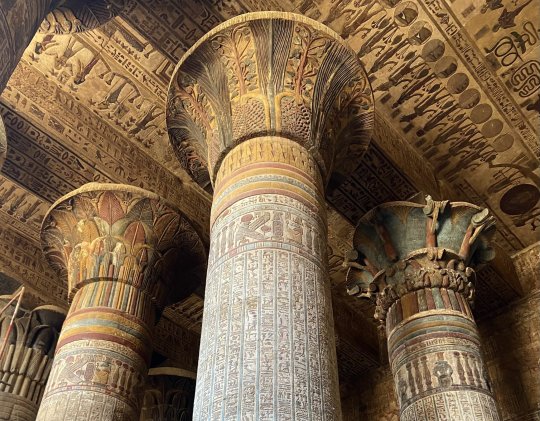
Temple of Khnum, Esna, Egypt
4K notes
·
View notes
Text

"The Complete Egyptian Religious Calendar for the year 2024: the most comprehensive publication of the lists of the festivities of the Egyptian Religious Tradition (dated for the year 2024). A practical application of the Egyptian Religious Calendar for the current age.
What’s new in this edition:
In this edition you will find, for the first time, the list of the Chronokratores and the Presiding Deities of the days of the year from the top frieze of the Outer Vestibule, also known as the Offering Hall, of the Temple of Horus at Edfu.
Contents:
- Preface
- The Egyptian Religious Calendar
- The Calendars of Ancient Egypt
- The Civil Calendar
- The presiding Deities and the Chronokratores of the days of the year
- The Sothis-based Lunar Calendar
- The Lunar months
- The Deities of the days of the Lunar month, the names of the days of the Lunar month, and their presiding Deities
- Favorable and adverse days
- Sources
- Egyptian Religious Calendar for the year 2024
- Notes
- Bibliography
The sources used to reconstruct the Egyptian Religious Calendar and for the dating of the sacred festivities are:
– the “Cairo Calendar n. 86637”
– the “Sallier papyrus IV”
– the “Budge papyrus”
– the list of the religious celebrations dated to the Middle Kingdom
And the lists of the sacred festivities from the Temples’ religious calendars:
– the religious calendar of King Thutmosis III from Ipet-Sut-Karnak
– the Temple of King Thutmosis III at Elephantine
– the Temple of King Ramses II at Abydos
– the Temple of Millions of Years of King Ramses III at West Uaset-Thebes (“Medinet Habu”)
– the Temple of Horus at Edfu
– the Temple of Hathor at Dendera
– the Double Temple of Haroeris and Sobek at Ombos (“Kom Ombo”)
– the Temple of Neith and Khnum at Esna"
— Egyptian Religious Calendar 2024: 424th-425th Great Year of Ra, by Luigi Tripani
37 notes
·
View notes
Text

The god Khnum (left) with the goddess Heqet (right) moulding Why in a relief at the Dendera Temple complex.
336 notes
·
View notes
Note
Ok, as a dumb outsider looking in, I feel like any discussion of fertility and religion needs to talk about agriculture deities, the fertile soil and plants, Geb, Dionysus, Demeter etc, and the rains/rivers : Khnum, Sobek, Thor, Zeus etc, Abrahamism doesn’t really seem interested in that sort of thing, and I’m tempted to blame it on abrahamism originating from pastoralists rather than crop farmers?
Also as an aside, what are your thoughts on the idea of Female cosmetic coalitions? As like, a coherent concept, or is this a whacky pseudoscience thing.
well, for one, at least three (if not four) among the gods you mention trace their origin to 'pastoralist' religion on account of their origin among primitive Indo-Europeans (disregarding later syncretisms and syntheses)
the actual reply is under the read more, but in brief:
I think it's unhelpful to privilege only one function of any particular deity without mentioning the context of these functions, and their individual idiosyncrasies as anthropomorphised forces of nature; seldom do polytheistic deities possess only one function, and two similar functions are often the result of convergent evolution from totally distinct premises
Yahweh, for what it's worth, appears to have possessed an association w/ rain and agricultural produce(!) even prior to his total syncretisation with El; at the very least, I think it'd be unreasonable to consider Zeus or Thor but not Yahweh a fecund 'god of rain'
I think it's reasonable to talk of differences between pastoralist and agriculturalist religious systems in terms of their immediate priorities (bc obviously), but I'm extremely sceptical of this thing ethnologists like to do where they attempt to clearly differentiate pastoralist from agriculturalist deities. even if the primitive Indo-Europeans were pastoralist in character, most of their descendants were not; I find it hard to believe pastoralist deities can't be modified to fit an agriculturalist context—or vice versa
I'll devote a separate post to the FCC model; thank you for reminding me of it! I'm honestly sympathetic to it, not least bc it's among the few anthropological models for the emergence of behavioural modernity that makes an effort to consult archaeological evidence (making it, unlike basically every other model I've come across, directly testable). I'm torn on some of the model's conclusions, but I wouldn't regard it as pseudoscientific
as I said in this reply, I think the existence of deities associated with the soil, vegetation and earthly fecundity is not the same as having an entire religious system revolve around the encouragement of fertility. fwiw, I think simplifying any of the listed deities into fertility gods is uncharitable—Dionysus has nothing of Geb's elderly, aristocratic character, and does not share his function as founder of dynasties and judge of the dead; Geb, for his part, lacks Dionysus' association with drunkenness, mantic frenzy and rebirth, of which I'd say his function as god of vegetation—more specifically, undomesticated nature and wild beasts—is downstream (Egyptian Greeks themselves appear to have identified Geb with Cronus in Geb-Sobek's cult centre at Fayyum; Dionysus was conversely identified with Osiris at least since the Ptolemaic period). in any case, polytheism seldom functions in simple epithets like 'god of plants' or 'god of rain', who more often conceal the actual attributes and functions of any particular god than they reveal anything about their place within the religious system
Yahweh appears to had been associated with earthly fecundity and agricultural produce; most obviously, the three pilgrimage festivals (pesach, shavuot and sukkot) all coincide with the annual harvest of barley, wheat and fruits in palestine; assuming the religious mandates for visiting Yahweh's temple in Jerusalem during the three festivals (in tandem with the annual gathering of produce!) go back to the United Monarchy, it is likely they predate the institutionalisation of monotheism in Israel
while I'd once again advise against simple associations, Yahweh could presumably warrant the title of a god of rain and produce under your definition—he's credited with causing rain (cf. in Judges 5:4-5) and the origin of his name, while ambigious, might be linked with a verb meaning 'to beget'; compare the Amorite construction yahwi-(x), '(subject) brings to life'. this is all downstream, of course, from the fact Hebrews appear to had abandoned a lifestyle of pastoralism for sedentary agriculture by the 12th century BCE, marked by the simultaneous introduction of terrace farming and cisterns—by the emergence of the United Monarchy during the early Iron Age (10th cent. BCE), the Hebrews were evidently not a primarily pastoralist people, and I'd imagine their prioritisation of certain deities in cult (as well as the attributes of deities inherited from the preceding pastoralist period) would reflect that
while I'm not very knowledgeable about Hebrew history before the establishment of the United Monarchy, I'm fairly sure one of the leading theories on the origin of the Hebrews is that they were the ethnically heterogenous descendants of Canaanites forced out of established (agricultural) settlements onto the highlands of the Sinai and southern Canaan—exclusive pastoralism would thus represent a relatively short interlude during early Hebrew history. this is all excluding the later adaptations of Hebrew religion to the sophisticated centralised bureaucracy of the United Monarchy, ofc
all that aside, as far as 'Abrahamism' as a singular entity is concerned, only the Arabs remained preferential pastoralists up to the moment of their transition into exclusive monotheism—and even then, their transition into monotheism assumed the form of a religious system coined and practiced primarily by settled agriculturalists being adapted to the Arabs' pastoralist context. like, it seems pretty obvious to me interactions between agriculturalist and pastoralist peoples are far too complex to clearly differentiate their respective religious systems along the lines of lifestye
5 notes
·
View notes